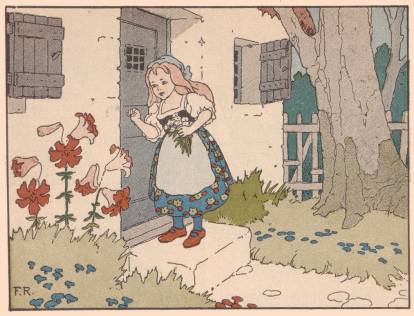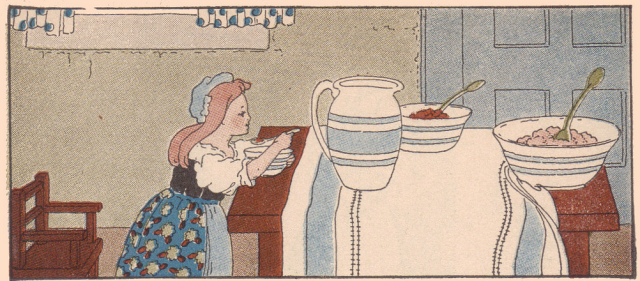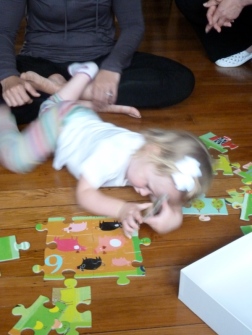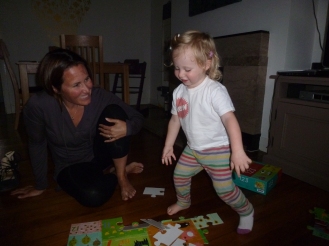
Goldilocks knocks at the door of learning.
…
“The New Winston Primer Manual” by Sidney G. Firman and Ethel Maltby Gehres. Published by The John C. Winston Co., 1928. Illustrated by Frederick Richardson.
When designing ideal conditions for learning, we do well to consider the case of Goldilocks. If we make a lesson too difficult, our learner may shut down in frustration. Make it too easy and the learner walks away in boredom. In between those two poles lies a “Just Right” moment, a learning location that both fits and stretches.
We all know that feeling of overwhelm when we simply cannot understand what’s being asked of us. That’s a time when we want to run and hide. Many students—and their parents who visit on Family Days—talk that way about math classes, as if the teacher were conducting class in a foreign language. Often, when I’m in a Spanish-speaking country, I can have the same experience.[1] Most words and sentences, I can follow fine. If someone gets going too quickly, however, I start to lose everything. The sounds become more like background noise. Nothing at all can come in.
I see that same shutdown sometimes at spring tryouts for softball. When the girls first get back in the hitting cage after five months of not picking up a bat, they can struggle. Last year, one of my best hitters literally swung and missed at all fifteen pitches she saw in her first session. At that point, no instruction or suggestion I could have offered would have been likely to help. She was feeling too frustrated to continue and needed a break before trying again. As Goldilocks might say, “Too hard.”
In behavioral training, we talk about “rate of reinforcement.” A learner needs to experience enough success—and reward—to keep their focus locked in. In a focused TAGteach session, when we work on a super-specific skill using an acoustical marker or “tag” to mean Yes, that’s it, we always begin with a baseline task where we know our learner has already established good command. They start with the success and build from there. Step by step, the skill develops in progression.
It’s also important that we don’t go too far and make our lessons saggingly easy. One of our primary human motivations—perhaps in the same family of needs as food, shelter, and love—is that of seeking. We want to investigate what’s around us so we can appreciate it, change it, or improve it. We want to relate with our environment. We want to learn and grow. That internal pull leads us to play at the limits of our abilities. I wonder if I can get over this hurdle. What happens if I try this angle? If we only see what we’ve already found, that seeking mechanism withers away and life becomes aimless or apathetic. We need an off-balance moment before we can take a next step.
One of the ways I introduce this notion in classes or in presentations is to ask listeners to fold their arms in front of them. Go ahead, you can play along too. Once you’ve done that first fold, notice which of your arms crosses over on top and then switch them so that the other arm crosses on top. Odds are, you now feel a bit uncomfortable. You’re not in pain, but you’re in unfamiliar territory. Something’s different and your brain is having to work to make sense of what’s happening. This isn’t the usual path we go down, now is it? You’ve used your body to prime your mind for learning.

“Too soft.”
…
From “We Three, A Primer” by Alberta Walker and Ethel Summy, with illustrations by Grace P. Smith. Published by Charles E. Merrill Co., 1929.
Rather than preparing us for a ready stance for learning, however, our society has inched us away from discomfort, ratcheting us into a sense of entitlement or laziness where we think we should never have to struggle or fail. Heck, we should never feel any pain of any sort. We inflate grades and backslide our expectations. Everyone gets a blue ribbon. All children are above average. When teachers and parents take away our discomfort—by not asking enough, by solving our problems for us, or by giving us praise for innate abilities rather than for effort—they deprive us of our own success and the joy of discovering our own abilities. Goldilocks would shake her head and say, “Too soft.”
Sometimes we make things easier because we don’t want the learner to suffer through the struggle. We think their self-esteem will falter or they’ll somehow be undone. Too, though, we sell our learners short. They’re tough. They’re resilient. It’s actually our own discomfort as teachers that we seek to quiet. We don’t want to be seen or known as the meanie or the bad guy.[2] We think we’re not good teachers or parents if they don’t “get it.” Or perhaps we’re bored or impatient and don’t feel like waiting any longer. Whatever the stimulus, it won’t help anyone’s success if I get noticeably upset as soon as my students get uncomfortable. That just teaches them to avoid discomfort altogether. I’d rather show them how to embrace it as a precursor to learning.
Just last month, I witnessed a great example of all this. I was with my friend Sarah, her two-year-old daughter Zanna, and their nanny, Sabrina. All four of us sat on the living room floor as Zanna worked her way through a simple puzzle.
Zanna was having a grand old time, sorting through colors and shapes and patterns to find which pieces might go together. And the three adults all tried to lead her to learn with different tolerance levels for her imbalance. My inclination was to up the challenge. I might say “So, Zanna, you know you’re looking for another piece with piggies. Do you see any other piggies or parts of piggies on the other pieces?” And, then, I’d watch her eyes sort through the available possibilities to track it down, not helping or leading. Sarah might bring a piggy piece from the periphery and put it somewhere in the mix closer to Zanna. And Sabrina several times found the needed piece herself and then placed it directly in front of Zanna, right where it went into the puzzle.
I don’t necessarily mean to suggest that my way was best here. Maybe my taskmaster challenge would have turned Zanna away from the puzzle in a minute or two. Sarah, in particular, has a mother’s keen insight into Zanna’s larger arc of learning. She knows how Zanna’s moods and meals shift her endurance for struggle, how many times she’s done this puzzle, and so on. Sarah knows that working, at this point, on shapes would prove too much, but working with sets—Where are the sunflowers?—would not. A great teacher knows her student this well. Still, I did and do think that Sabrina’s approach robbed Zanna of an opportunity to get through the challenge herself. The kid lost a chance for the delight of her own success.
Clearly, the ideal ground lies somewhere between the two extremes of certain failure and certain success. As with breathing, we want the exertion of drawing air in and the relaxation of letting it go. We challenge and then allow. Challenge, then allow. Here, we start ratcheting in reverse—not towards slothful entitlement but instead towards skillful expertise. When we get it really right, we won’t settle with the first in-between spot we find. We keep digging further.
In other words, our work as teachers is not just to provide the disequilibrium that stimulates learning. It’s also to increase a tolerance for—even develop a longing for—the disequilibrium itself. We want to live in the center between two poles and we want to shift that center along on the spectrum. Ultimately, we hope that Goldilocks eventually learns to bounce off “too hard,” take a pass on “too easy,” and seek out an imbalance that’s “just right” for learning. If we as teachers can check our own discomforts with challenge, we can help her get there.

Mmmm, that off-balance porridge looks gooooood.
…
From “The New Winston Primer Manual” by Sidney G. Firman and Ethel Maltby Gehres. Published by The John C. Winston Co., 1928. Illustrated by Frederick Richardson.
[1] In that case, of course, people are speaking a foreign language.
[2] Students at Northfield Mount Hermon elect a Student Choice Award each year for their favorite faculty and staff members. I’d love to receive the honor, but I doubt I ever will—I have too strong a reputation as a “harsh grader—fair, but harsh.” I like that students know they’ll have to work to succeed in my classes, but I can also admit that it stings a little to know that that rep may work against how much they “like” me.




[…] into smaller chunks, she needs to choose which steps will lead most fluidly to the desired ability: too easy and learners get bored, too demanding and they’ll get frustrated. And she needs to mark the behavior with exquisite accuracy, capturing the ‘yes’—even […]